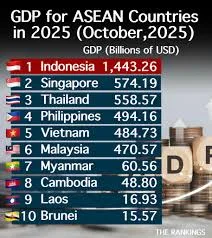The Asian economic growth witnessed a significant announcement from the International Monetary Fund (IMF).
The Fund raised its economic growth forecasts for Asia, sending a strong message about the region’s resilience and its ability to achieve expansion rates that exceed the global average.
This financial optimism reflects the continued economic dynamism in the region, led by major powers such as China and India.
| However, the report was not without a clear note of caution, as the IMF warned of risks to these forecasts due to trade policy uncertainty. |
This balance between “growth despite warnings” and global trade challenges paints a complex picture of the future of Asian growth forecasts.
Asia Leads Global Growth
The IMF’s decision to raise growth forecasts for Asia was driven by strong, above-expected economic performance in several major economies in the region. The Fund pointed to several factors contributing to this optimism:

Rebound in domestic demand:
Many Asian countries have begun to experience a marked recovery in consumer spending and private investment, supported by easing inflationary pressures in some markets.
• Resilient exports: Despite the global slowdown, Asian exports have shown relative resilience, particularly in the electronics and technology sector, as the region continues to serve as the world’s factory.
• Supportive policies: Asian governments have, for the most part, successfully implemented supportive fiscal and monetary policies that have enhanced economic stability and enabled the continuation of infrastructure projects.
The Fund has raised its GDP forecast for the region (usually given as a percentage here) to place it among the fastest-growing economic regions in the world. This figure reflects the pivotal role Asia plays in driving the global economy.
Trade Policy Risk: The Specter of Uncertainty
Despite the optimistic outlook, the IMF’s warning on trade policy is not just a routine warning; it represents a real concern that threatens to undermine the foundation of Asian growth. The report identified the following key risks:
• Escalation of protectionism: The Fund noted that global trade tensions, particularly between the United States and its major trading partners in Asia, could lead to the imposition of further tariffs and trade restrictions.
This escalation would disrupt the global supply chains on which Asia relies heavily, increasing production costs and reducing trade volume.
• Geoeconomic fragmentation: The Fund warned that the shift toward closed economic blocs and away from globalization could harm Asian countries that rely on open markets and the free flow of goods and services.
This fragmentation threatens to divert trade investment away from the region.
• Slowing external demand: Trade uncertainty is weakening confidence in global markets, potentially slowing demand from advanced economies for Asian exports, thus weakening the region’s main engine of growth.
• Debt and inflation: In addition to trade risks, high debt levels in some countries, along with persistent inflationary pressures in some sectors, pose domestic challenges that could be exacerbated by a contraction in global trade.
Implications for Major Asian Economies
Asian economies are affected by these forecasts and risks to varying degrees. While China and India continue to grow strongly, supported by large domestic markets, smaller, more export-dependent economies, such as South Korea, Taiwan, and some Southeast Asian countries, are more vulnerable to fluctuations in global trade policy.
The IMF sees India as having the potential to become the world’s new major growth center, but it needs to address structural reforms and accelerate investment.
China, while maintaining strong growth, still faces challenges related to its real estate sector and the need to rebalance the economy toward domestic consumption.
The IMF’s message is a clear call for Asian policymakers to prepare for downside scenarios, diversify markets, and enhance regional cooperation to counter the risks of global protectionism.
Expected growth is not a given unless trade risks are skillfully managed.
Key News Points
• Raising Forecasts: The IMF raises its forecast for economic growth in Asia, emphasizing the region’s resilience and its role as a leader in global growth.
• Trade Policy Risk: The IMF’s most prominent warning is the uncertainty associated with global trade policies and rising protectionism.
• Market Fragmentation: The risk lies in the fragmentation of global trade, which threatens supply chains and negatively impacts export-dependent Asian economies.
• Diversification Need: Asian countries must diversify their markets and enhance regional cooperation to reduce dependence on Western markets amid trade tensions.
• Supportive Factors: The recovery in domestic demand, the resilience of the technology sector, and exports are key factors supporting the positive outlook for Asian growth.
